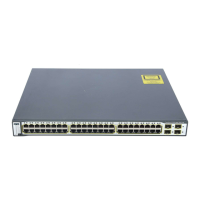Contents
xiv
Catalyst 3750 Switch Software Configuration Guide
78-16180-02
IP Addressing Scheme with Private VLANs 15-3
Private VLANs across Multiple Switches 15-4
Private-VLAN Interaction with Other Features 15-4
Private VLANs and Unicast, Broadcast, and Multicast Traffic 15-5
Private VLANs and SVIs 15-5
Private VLANs and Switch Stacks 15-5
Configuring Private VLANs 15-6
Tasks for Configuring Private VLANs 15-6
Default Private-VLAN Configuration 15-7
Private-VLAN Configuration Guidelines 15-7
Secondary and Primary VLAN Configuration 15-7
Private-VLAN Port Configuration 15-8
Limitations with Other Features 15-9
Configuring and Associating VLANs in a Private VLAN 15-10
Configuring a Layer 2 Interface as a Private-VLAN Host Port 15-11
Configuring a Layer 2 Interface as a Private-VLAN Promiscuous Port 15-13
Mapping Secondary VLANs to a Primary VLAN Layer 3 VLAN Interface 15-14
Monitoring Private VLANs 15-15
CHAPTER
16 Configuring Voice VLAN 16-1
Understanding Voice VLAN 16-1
Cisco IP Phone Voice Traffic 16-2
Cisco IP Phone Data Traffic 16-2
Configuring Voice VLAN 16-3
Default Voice VLAN Configuration 16-3
Voice VLAN Configuration Guidelines 16-3
Configuring a Port Connected to a Cisco 7960 IP Phone 16-4
Configuring IP Phone Voice Traffic 16-4
Configuring the Priority of Incoming Data Frames 16-6
Displaying Voice VLAN 16-6
CHAPTER
17 Configuring STP 17-1
Understanding Spanning-Tree Features 17-1
STP Overview 17-2
Spanning-Tree Topology and BPDUs 17-3
Bridge ID, Switch Priority, and Extended System ID 17-4
Spanning-Tree Interface States 17-5
Blocking State 17-7
Listening State 17-7

